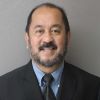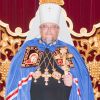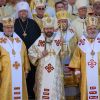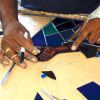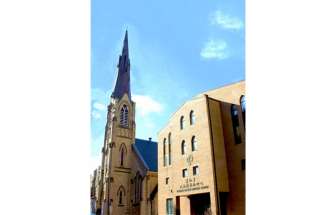Catholic trustee Tobias Enverga elevated to the Senate
TORONTO - For the second time Tobias Enverga has made Canadian political history.
After being the first Filipino-Canadian to hold a publicly elected position in Toronto, the Catholic school trustee has been appointed to the Canadian Senate.
"I'm the first Filipino-Canadian (senator) and we have some unique values that the Senate doesn't have yet and I want to share that," said Enverga, who is now a former Toronto Catholic District School Board trustee after his appointment. "It's a big honour for me and a big honour for our community at the same time."
Prime Minister Stephen Harper's office announced Enverga's election to the Red Chamber on Sept. 7, which fills an Ontario seat vacancy. He, along with four other new senators announced the same day, will officially be sworn in on Sept. 25 in Ottawa.
The five new senators, who have an allegiance to the Conservatives, swells the majority government's chamber representation to 62 in the 105-seat Senate.
When Enverga received the phone call telling him he had been chosen as a senator, he was shocked. Not only did he not know he'd been nominated, Enverga, 56, didn't even really know what a senator did.
"Never in my wildest dreams did I think I was going to be in one of the highest positions in the land," said Enverga. "Like any other new position there will be new challenges. I'm not sure what the new challenges will be because this is the first time that I've heard about the position actually."
But treading unfamiliar waters is nothing new to Enverga, who arrived in Canada in 1981 seeking "adventure and a good job."
Employed by the Bank of Montreal since arriving here, most recently as a project manager, Enverga sought adventure again in 2010 when he ran for Catholic school trustee.
As a senator Enverga had to give his two weeks notice to the bank and resign from his trustee position.
"According to the by-laws I cannot hold two jobs, especially as a senator and trustee," he said.
Although Enverga said he feels bad about leaving the ratepayers who voted for him, this new position will allow him to help a broader range of people. And he believes his experience with the TCDSB can only help him in his new position.
"The good thing is that the Catholic school board has given me the experience to deal with issues and deal with people at the same time," said Enverga, adding that the economy will be a large area of focus while sitting in the Red Chamber. "It's a big challenge but God will not give me anything that I cannot do."
The TCDSB has not decided how it will fill Enverga's seat. It could call a by-election or appoint an interim trustee.
Orthodox leader: North's America's churches can be example for Ukraine
PORTAGE LA PRAIRIE, Manitoba - Catholic and Orthodox churches in Canada and the United States can be an example for their counterparts in Ukraine, Canada's top Ukrainian Orthodox leader told the Ukrainian Catholic Synod of Bishops.
Ukrainian Orthodox Metropolitan Yurij of Winnipeg, addressing the worldwide synod Sept. 10, told the bishops it was "evident that our God is blessing us and helping us develop this better relationship."
"We also pray that in Ukraine this same attitude will develop as well," he said at the first meeting of the synod. The synod is private, but part of its initial session was open to media.
Metropolitan Yurij told several dozen Ukrainian Catholic bishops that the North American Catholic and Orthodox bishops have worked through the "animosity" that once marked relations between their Churches, and they now collaborate.
"In Ukraine, they have to go through the same kind of process," he said, and the bishops outside Ukraine must be patient with their brothers.
While the majority of Ukrainians are Orthodox, they are divided into three Churches: one in communion with the Russian Orthodox Church, one with a patriarch in Kiev and the third known as the Autocephalous Ukrainian Orthodox Church.
The forced unification of the Ukrainian Orthodox Church with the Moscow Patriarchate of the Russian Orthodox Church in the 1940s "is one of the principal problems," the metropolitan said.
The 2010 election of Ukrainian President Viktor Yanukovych, a member of the Orthodox Church in communion with the Moscow Patriarchate, appears to have fueled long-standing tensions between Orthodox loyal to Moscow and those who support an independent Orthodox Church in Ukraine. Yanukovych has worked to strengthen ties with Russia.
Metropolitan Yurij did not mention politicians. However, he did note that the Russian-affiliated Ukrainian Orthodox Church is the only one canonically recognized by the Ecumenical Patriarchate of Constantinople. So, for instance, when Patriarch Filaret of the Ukrainian Orthodox Church-Kiev Patriarchate visited Canada in April, Metropolitan Yurij did not meet with him.
"I have directors also," he said, referring to the ecumenical patriarch, considered first among equals of Orthodox leaders. "I am part of the community of the Orthodox, and he (Patriarch Filaret) is not recognized as a patriarch, so I could not meet him."
Archbishop Sviatoslav Shevchuk of Kiev-Halych, Ukraine, the elected head of the Ukrainian Catholic Church, told Metropolitan Yurij he often finds himself caught in the middle of the delicate situation in Ukraine.
Shevchuk deals with leaders of all three Ukrainian Orthodox churches. Yet every time he has contact with someone from one of the non-canonical Ukrainian Orthodox Churches, "right away a letter goes from Moscow to Rome" asking why the Ukrainian Catholic Church is collaborating with them.
"Directly or indirectly ... I end up being a kind of a go-between between the Orthodox Church and the Roman Catholic Church," he said.
Shevchuk said he, like his predecessor, Cardinal Lubomyr Husar, believes that "we can and we must be ambassadors of the whole Kievan Church," a term used to refer to all Eastern churches based in Ukraine.
Metropolitan Yurij and Winnipeg Archbishop James Weisgerber thanked the synod members for inviting them to the opening session and to the previous day's Divine Liturgy.
Weisgerber, former president of the Canadian Conference of Catholic Bishops, told them, "Sometimes we get the impression that — because the Roman Catholic Church is so large — that it has nothing to learn from anyone else.
"This is a great, great mistake. Often the smallest have the most important things to say," the archbishop said.
The synod was scheduled to meet behind closed doors in Portage la Prairie until Sept. 15 before a public closing celebration in Winnipeg Sept. 16.
Brampton school mourns football player Gene Odulio
BRAMPTON, ONT. - Flags flew at half-mast at Brampton's St. Thomas Aquinas Catholic Secondary School Sept. 10 in memory of Gene Odulio, 17, who passed away the day before in hospital after he collapsed during a high school football game Sept. 7.
Odulio mysteriously collapsed during an exhibition football match against the visiting Brantford Collegiate Institute. After huddling with his team's defence squad, Odulio, a four-year veteran, fell limp onto the field with about nine minutes remaining in the fourth quarter. He was rushed to Toronto's Sunnybrook Hospital in critical condition.
"It was a very sad environment at the school this morning ... liturgies were held throughout the morning to remember Gene," Bruce Campbell, spokesperson for the Dufferin-Peel Catholic District School Board, said. "That's one of the things about a Catholic school, that we can rely on our faith to help us to grieve and better understand or at least better accept that we are all part of a greater plan."
Campbell said it was a head injury that felled the defensive back. Odulio had no history of head injuries, at least to the school's knowledge.
"There was no discernible hit or triggering playing in the game where you could identify that he might have been injured," said Campbell. "But clearly it was a head injury of some type, he did have swelling so it was a brain injury for sure."
Remembered as an outgoing and popular student, football stood out as Odulio's passion in life.
"He was very passionate about football and that seemed to be a major passion in his life," said Campbell.
The school is considering retiring Odulio's number, a bittersweet tribute to the Grade 12 student, said Campbell.
Ukrainian Catholic bishops in Winnipeg to discuss next steps in vibrant-parish plan
WINNIPEG - Ukrainian Catholic bishops from around the world gathered in Winnipeg to discuss how to make their parishes more vibrant — especially through the involvement of laypeople.How they do that requires solutions as varied as the parishes that represent more than four million Ukrainian Catholics on four continents.
"We have parishes that are growing" and need pastoral, financial and structural support, said Bishop Ken Nowakowski of New Westminster, B.C., who heads the Ukrainian Catholic Church's implementation team for its strategic plan, "Vision 2020."
Some urban parishes have an aging population and declining numbers, and synod members must decide how to support the parish priest who spends so much time visiting the sick and officiating at funerals, said Nowakowski. At the other end of the spectrum, the bishops must consider how to help keep priests in busy, large parishes from burning out.
The vibrant parish initiative was approved by the synod in 2011 when the bishops met in Brazil. Their first steps have included making sure that clergy understand the plan and representatives of each of the Ukrainian Catholic eparchies, or dioceses, designated a priest-representative to help introduce the plan within the diocese.
Nowakowski said that about 70 per cent of the world's 4,500 Ukrainian Catholic priests have given feedback and are involved with the plan. This year Church leaders hope to involve religious communities and monastics, he said. He told Catholic News Service he would present synod members with a report on what has been accomplished and would include feedback. Synod members will either ask the committee to continue with its current plan or make changes, he added.
The Synod of Bishops, the Ukrainian Catholic Church's governing body, normally meets in Ukraine, but it is meeting in Canada Sept. 9-16 in honour of the centenary of the arrival of Canada's first Ukrainian Catholic bishop, Blessed Nykyta Budka.
Winnipeg's Ukrainian Archbishop Lawrence Huculak said as bishops from other countries arrived for the synod, they were impressed with the involvement of Canada's laity. Even the synod's organizational committee has laypeople on it, he said.
"It's not just the bishops ... the people are taking part and helping to organize it," he said.
Ukrainian Catholics in Canada have women's, men's and youth groups. Lay groups have national conventions, elect leaders and participate in the life of the Church.
"Although we (Canadians) may take it for granted, our laity have not been able to organize themselves in the same way" in some other countries, he said.
Last December, the head of the Ukrainian Catholic Church, Archbishop Sviatoslav Shevchuk of Kiev-Halych, Ukraine, outlined his vision in a pastoral letter to Ukrainian Catholics worldwide. In the letter, "The Vibrant Parish — A Place to Encounter the Living Christ," he spoke of the elements needed to "grow in holiness and unity in Christ Jesus."
Shevchuk said people of all ages must continue to learn about the faith — not only from the Bible, but also from the Catechism of the Catholic Church. Priests must teach and laity have a responsibility to learn because "permanent and continuous formation for various age groups ... is an essential component of the vibrant parish."
Parishioners must participate regularly in the sacraments, and families must once again become "a school of prayer," he said.
"Our parishes can become places where care is given to the orphan, protection for the widow, help for the poor, and where the suffering of the sick is shared," he said.
Parishes must have active pastoral and parish councils as well as "well-formed and mature co-workers who assist the priest in leading catechetical schools, church brotherhoods, charitable works, youth organizations and prayer groups," he said. "One of the most important responsibilities of leadership in the parish community is discerning God's will and searching for the best ways of implementing it in the life of the parish."
Everyone in the parish must have a missionary spirit, he said.
Stained glass, a time-honoured tradition
TORONTO - Tools, training and talent aside, the one thing you really need to make a piece of stained glass is time.
“A stained glass window, if it is truly a stained glass piece, you put in about five months,” said Joseph Aigner, owner of Artistic Glass since it opened in 1971. “That’s realistic. If it is just coloured glass and leading, that’s different.”
For a piece to be genuine stained glass one must paint it, heat it in a kiln to 677 degrees Celsius, and repeat as necessary. Each time this is done, four times on average to produce a detailed face, it takes about 16 hours because once the glass is heated it requires half a day to cool before a second coat of paint can be applied.
Not only is this the defining characteristic of stained glass, it is also a very time-consuming stage of the process — one which many people never associate with the semi-transparent art work.
“A lot of people have the imagination that this is what stained glass is,” said Aigner, pointing to large piece of coloured glass that had been tinted during the manufacturing of the solid glass sheet. “You have to then inform them that what they have is coloured glass leaded together.”
Aside from the paint and bake component, the process of making a piece of artistically leaded glass — be it clear, stained, coloured or more commonly a combination — is the same.
A design is composed and once it satisfies the collective vision of those involved, a full-scale version is drawn up. One of these drawings is then taken and, using wide-blade scissors to compensate for the necessary gaps for leading, cut into the individual sections. These patterns, labelled for further reference, are used to cut out each piece of glass by hand.
Leading is when the multiple sections of glass are bound together. To do this a full-scale pattern is laid out on a table which has one corner fitted with a molding boarder. The molding, which sits higher than the table’s surface, provides the artist with a ridged edge to pin the glass pieces against as stripes of lead are used to frame each.
Once the entire project is laid out and leaded, including the outer edge, all joints are soldered together and then sealed with a specially mixed glue.
How long this all takes varies as much as the number of combinations you can make.
“(It) depends on how many pieces are in it, how difficult it is,” said Aigner, who picked up the craft as a child while working at his family’s glass shop in Germany. “When we make a church project it can take sometimes up to two years to complete.”
There are two major reasons why stained glass windows for churches take so long, said Aigner. First, priests want real stained glass, although most accept a mixture of coloured and stained to keep costs down. The second reason, church projects are large, complex and often multi-window assignments intended to please hundreds of parishioners meaning the design phase is rarely a first-draft success.
“The most challenging thing is to get the design approved,” said Aigner, who is four months into an eight-window project, each representing one of the Beatitudes, for St. Augustine Catholic High School in Markham, Ont. “We had a little bit of a problem finding images for the Beatitudes. I had a little trouble getting a concept ... but now we have a beautiful design.”
Ontario's Catholic school trustees seek change to McGuinty's Putting Students First Act
Ontario’s Catholic school trustees are pressing for changes to Dalton McGuinty’s Putting Students First Act and insisting that Catholic school boards should not be legally bound to new teacher contracts imposed by the government.
OCSTA officials will continue to push for amendments to the act to remove contentious clauses that strip school boards of important management rights pertaining to teacher hiring and student testing, said Bob Murray, OCSTA director of legislative and political affairs.
Under the proposed new law, Catholic boards will be required to operate by more restrictive policies than the province’s public boards. That inequality was created in late August when the government backtracked on Putting Students First and returned to French and public boards the right to negotiate non-salary issues with their unions. But the same right was denied to Catholic boards.
The government had previously done a deal and signed a memorandum of understanding (MOU) directly with the union that represents Catholic teachers, the Ontario English Catholic Teachers’ Association (OECTA). That deal was negotiated without input from Catholic trustees and their boards, and was allowed to stand after the government relented to opposition party demands to amend Putting Students First.
“While the union has signed, the boards themselves, as the legal employer, refused to sacrifice those rights (pertaining to hiring and testing) that are legally theirs,” Murray said. “So, for no reason should they be legally bound to an agreement they didn’t sign.”
Five Catholic boards had previously agreed to accept the terms negotiated between the government and OECTA and, said Murray, those boards are legally bound to honour the contract they signed. But OCSTA believes the other 24 Catholic boards should have the same negotiating rights as the public boards.
“We have these agreements that were not reached according to the legal collective bargaining process,” said Murray, adding that “labour relations rights of employers and employees have been violated.”
The trustees are concerned that granting teacher unions more input in hiring and a greater say in managing diagnostic testing will negatively impact the quality of education. In a statement, OCSTA expressed concern that decisions about education are being made for reasons of political expediency.
“These rights are important because of the impact they have on students and the quality of education delivery,” said Murray
OCSTA officials were to meet with Liberal and opposition party members to make their case for change.
“There will be opportunities for amendments to be put forward and our hope is that the opposition parties will continue to push very strongly to have these two issues fully removed from the legislation,” said Murray. “Our intention and our desire would be for the bill to be amended further to remove those two provisions to be bound to any board at this point.”
According to a government spokesman, a final vote on Putting Students First is not expected before Sept. 10.
UBC students have a 'Dish with the Bish'
VANCOUVER - Food for the body and food for the mind were the two focal points at Dish with the Bish: Reheat, a combined potluck dinner and question-and-answer session for students with Vancouver Archbishop Michael Miller.
Million-dollar facelift at Toronto Chinese parish
Irish Catholic artist finds the ‘Undeniable Truth’
TORONTO - Yad Vashem is Israel’s official memorial to the victims of the Holocaust and to those non-Jews called the “Righteous Among the Nations” who helped save Jews at great personal risk. As a follow-up to this year’s Holocaust Education Week, the Canadian Society for Yad Vashem will be hosting an exhibition of 33 works by the Catholic Irish artist Thomas Delohery. The show is titled “Undeniable Truth.”


